Promoting Synergies to Improve Manufacturing Efficiency in Industrial Material Processing: A Systematic Review of Industry 4.0 and AI
Abstract
:1. Introduction
Role of AI in Enhancing Manufacturing Efficiency
2. Materials and Methods
2.1. Research Questions
- RQ1: What are the Industry 4.0 and AI technologies for improving material processing efficiency?
- RQ2: How can integrating Industry 4.0 with AI technologies optimize manufacturing efficiency?
- RQ3: What are the main challenges in adopting Industry 4.0 and AI technologies for manufacturing, and what future trends and emerging technologies have been proposed to overcome these challenges?
2.2. Search Strategy
2.3. Study Selection (Inclusion and Exclusion Criteria)
3. Results
3.1. Year-Wise Publication Progress
3.2. Highly Cited Papers (Global Citations)
3.3. Most Productive Journals
4. Discussion
- RQ1: What are the Industry 4.0 and AI technologies for improving material processing efficiency?
4.1. Industry 4.0 Technologies in Material Processing
4.1.1. IoT in Material Processing
4.1.2. Leveraging Big Data Analytics for Material Processing Optimization
4.1.3. CPS’s Role in Material Processing
4.1.4. AM and Robotics Integration in Industry 4.0
4.2. Enhancing Manufacturing Efficiency with AI
4.2.1. ML Algorithms for Process Optimization
4.2.2. Deep Learning Applications in Material Processing
4.2.3. Reinforcement Learning (RL) for Adaptive Manufacturing Systems
- RQ2: How integrating Industry 4.0 with AI technologies can optimize manufacturing efficiency in material processing?
5. Integration and Synergies between Industry 4.0 and AI
- RQ3: What are the main challenges adopting Industry 4.0 and AI technologies for manufacturing in material processing and what future trends and emerging technologies have been proposed to overcome these challenges?
6. Challenges, Opportunities, and Future Directions
6.1. Addressing Challenges of Adoption of Industry 4.0 and AI
- Integration and compatibility of technology
- Cybersecurity risks and data privacy
- Skills deficit and workforce development
- Feasibility study of finance
- Scalability and adaptability
- Real-time data processing and analysis
- Supply chain integration and collaboration
6.2. Future Directions: Emerging Trends
- Edge computing
- DTs
- AI-driven automation
- Blockchain throughout the supply chain
- Circular economy
- Standardization and Development of Interoperability of Industrial Protocols in Industry 4.0
- Preventive Maintenance Using Advanced AI
- Evolution of Cybersecurity from Industry 4.0 to 5.0
- Adaptation of Industry 4.0 Technologies for Small and Medium-sized Enterprises (SMEs)
7. Conclusions
- Firstly, this paper explores the current functions and potential of Industry 4.0 technologies in various production processes across various types of raw material processing companies. Furthermore, this work examines the impact of various Industry 4.0 technologies on all aspects of manufacturing process enhancement, which will benefit future research:
- Secondly, this paper highlights the most significant AI technologies, which, through a thorough application in many manufacturing subsystems, have demonstrated an increase in their performance through data anomaly detection, process parameter and resource optimization, and waste reduction;
- Thirdly, this study adopted the PRISMA method for an SLR and explores several options for manufacturing efficiency improvement through the synergistic influence of Industry 4.0 and AI technologies. The technologies of AI and Industry 4.0 and their impacts are as follows:
- RNN, Logistics Regressor with IoT, Cloud Computing, and Simulation have a significant synergistic effect on early fault detection, quality control, and the identification of anonymous data;
- Various ML algorithms with integration of Industry 4.0 are capable of handling real-time monitoring, prediction, and condition-based monitoring, allowing for the visualization of warnings and errors in any production system.
Author Contributions
Funding
Data Availability Statement
Conflicts of Interest
References
- Xu, X.; Lu, Y.; Vogel-Heuser, B.; Wang, L. Industry 4.0 and Industry 5.0—Inception, conception and perception. J. Manuf. Syst. 2021, 61, 530–535. [Google Scholar] [CrossRef]
- Masood, T.; Sonntag, P. Industry 4.0: Adoption challenges and benefits for SMEs. Comput. Ind. 2020, 121, 103261. [Google Scholar] [CrossRef]
- Kalsoom, T.; Ramzan, N.; Ahmed, S.; Ur-Rehman, M. Advances in Sensor Technologies in the Era of Smart Factory and Industry 4.0. Sensors 2020, 20, 6783. [Google Scholar] [CrossRef]
- Agrifoglio, R.; Cannavale, C.; Laurenza, E.; Metallo, C. How emerging digital technologies affect operations management through co-creation. Empirical evidence from the maritime industry. Prod. Plan. Control 2017, 28, 1298–1306. [Google Scholar] [CrossRef]
- Radziwon, A.; Bilberg, A.; Bogers, M.; Madsen, E.S. The Smart Factory: Exploring Adaptive and Flexible Manufacturing Solutions. Procedia Eng. 2014, 69, 1184–1190. [Google Scholar] [CrossRef]
- Gattullo, M.; Scurati, G.W.; Fiorentino, M.; Uva, A.E.; Ferrise, F.; Bordegoni, M. Towards augmented reality manuals for industry 4.0: A methodology. Robot. Comput. Integr. Manuf. 2019, 56, 276–286. [Google Scholar] [CrossRef]
- Haji, S.H.; Ameen, S.Y. Attack and Anomaly Detection in IoT Networks using Machine Learning Techniques: A Review. Asian J. Res. Comput. Sci. 2021, 9, 30–46. [Google Scholar] [CrossRef]
- Conway, J. The Industrial Internet of Things: An Evolution to a Smart Manufacturing Enterprise. Schneider Electric Whitepaper. 2015. Available online: https://it-resource.schneider-electric.com/white-papers/the-industrial-internet-of-things-an-evolution-to-a-smart-manufacturing-enterprise (accessed on 5 October 2020).
- Soori, M.; Arezoo, B.; Dastres, R. Internet of things for smart factories in industry 4.0, a review. Internet Things Cyber-Phys. Syst. 2023, 3, 192–204. [Google Scholar] [CrossRef]
- Georgakopoulos, D.; Jayaraman, P.P.; Fazia, M.; Villari, M.; Ranjan, R. Internet of Things and Edge Cloud Computing Roadmap for Manufacturing. IEEE Cloud Comput. 2016, 3, 66–73. [Google Scholar] [CrossRef]
- Abell, J.A.; Chakraborty, D.; Escobar, C.A.; Im, K.H.; Wegner, D.M.; Wincek, M.A. Big Data-Driven Manufacturing—Process-Monitoring-for-Quality Philosophy. J. Manuf. Sci. Eng. 2017, 139, 101009. [Google Scholar] [CrossRef]
- Li, L. Research on the Characteristics of Industrial Talent Demand Depending on Big Data Technology. J. Electr. Syst. 2024, 20, 1259–1271. [Google Scholar] [CrossRef]
- Beidouri, Z.; Naji, A.; Fadile, L. Supply Chain Management for Additive Manufacturing; Springer International Publishing: Cham, Switzerland, 2023. [Google Scholar]
- Ding, B.; Ferràs Hernández, X.; Agell Jané, N. Combining lean and agile manufacturing competitive advantages through Industry 4.0 technologies: An integrative approach. Prod. Plan. Control 2023, 34, 442–458. [Google Scholar] [CrossRef]
- Francis, L.F. Introduction to Materials Processing. In Materials Processing; Elsevier: Amsterdam, The Netherlands, 2016; pp. 1–20. [Google Scholar]
- Arinez, J.F.; Chang, Q.; Gao, R.X.; Xu, C.; Zhang, J. Artificial Intelligence in Advanced Manufacturing: Current Status and Future Outlook. J. Manuf. Sci. Eng. 2020, 142, 110804. [Google Scholar] [CrossRef]
- Achouch, M.; Dimitrova, M.; Ziane, K.; Sattarpanah Karganroudi, S.; Dhouib, R.; Ibrahim, H.; Adda, M. On Predictive Maintenance in Industry 4.0: Overview, Models, and Challenges. Appl. Sci. 2022, 12, 8081. [Google Scholar] [CrossRef]
- Azarian, M.; Yu, H.; Solvang, W.D. Correction to: Integrating Additive Manufacturing into a Virtual Industry 4.0 Factory. In Advanced Manufacturing and Automation X 10; Springer: Singapore, 2021. [Google Scholar]
- Bhatt, P.M.; Malhan, R.K.; Shembekar, A.V.; Yoon, Y.J.; Gupta, S.K. Expanding capabilities of additive manufacturing through use of robotics technologies: A survey. Addit. Manuf. 2020, 31, 100933. [Google Scholar] [CrossRef]
- Rao, A.S.S.; Rao, C.R.; Krantz, S. Artificial Intelligence; Elsevier: Amsterdam, The Netherlands, 2023. [Google Scholar]
- Nozari, H.; Ghahremani-Nahr, J.; Szmelter-Jarosz, A. AI and machine learning for real-world problems. In Advances in Computers; Elsevier: Amsterdam, The Netherlands, 2023. [Google Scholar]
- Wang, S.; Zhang, J.; Wang, P.; Law, J.; Calinescu, R.; Mihaylova, L. A deep learning-enhanced Digital Twin framework for improving safety and reliability in human–robot collaborative manufacturing. Robot. Comput. Integr. Manuf. 2024, 85, 102608. [Google Scholar] [CrossRef]
- O’Donovan, C.; Giannetti, C.; Pleydell-Pearce, C. Revolutionising the Sustainability of Steel Manufacturing Using Computer Vision. Procedia Comput. Sci. 2024, 232, 1729–1738. [Google Scholar] [CrossRef]
- Costa, A.P.O.; Seabra, M.R.R.; César de Sá, J.M.A.; Santos, A.D. Manufacturing process encoding through natural language processing for prediction of material properties. Comput. Mater. Sci. 2024, 237, 112896. [Google Scholar] [CrossRef]
- Waltersmann, L.; Kiemel, S.; Stuhlsatz, J.; Sauer, A.; Miehe, R. Artificial Intelligence Applications for Increasing Resource Efficiency in Manufacturing Companies—A Comprehensive Review. Sustainability 2021, 13, 6689. [Google Scholar] [CrossRef]
- Hassani, I.; Mazgualdi, C.E.; Masrour, T. Artificial Intelligence and Machine Learning to Predict and Improve Efficiency in Manufacturing Industry; IEEE: New York, NY, USA, 2019. [Google Scholar]
- Ashima, R.; Haleem, A.; Bahl, S.; Javaid, M.; Kumar Mahla, S.; Singh, S. Automation and manufacturing of smart materials in additive manufacturing technologies using Internet of Things towards the adoption of industry 4.0. Mater. Today Proc. 2021, 45, 5081–5088. [Google Scholar] [CrossRef]
- Kaleem, M.A.; Khan, M. Significance of Additive Manufacturingfor Industry 4.0 with Introduction of Artificial Intelligence in Additive Manufacturing Regimes. In Proceedings of the 2020 17th International Bhurban Conference on Applied Sciences and Technology (IBCAST), Islamabad, Pakistan, 14–18 January 2020; IEEE: New York, NY, USA, 2020; pp. 152–156. [Google Scholar]
- Huang, Y.; Leu, M.C.; Mazumder, J.; Donmez, A. Additive Manufacturing: Current State, Future Potential, Gaps and Needs, and Recommendations. J. Manuf. Sci. Eng. 2015, 137, 014001. [Google Scholar] [CrossRef]
- Dilberoglu, U.M.; Gharehpapagh, B.; Yaman, U.; Dolen, M. The Role of Additive Manufacturing in the Era of Industry 4.0. Procedia Manuf. 2017, 11, 545–554. [Google Scholar] [CrossRef]
- Gao, W.; Zhang, Y.; Ramanujan, D.; Ramani, K.; Chen, Y.; Williams, C.B.; Wang, C.C.L.; Shin, Y.C.; Zhang, S.; Zavattieri, P.D. The status, challenges, and future of additive manufacturing in engineering. Comput.-Aided Des. 2015, 69, 65–89. [Google Scholar] [CrossRef]
- Lee, C.; Seo, G.; Kim, D.B.; Kim, M.; Shin, J.-H. Development of Defect Detection AI Model for Wire + Arc Additive Manufacturing Using High Dynamic Range Images. Appl. Sci. 2021, 11, 7541. [Google Scholar] [CrossRef]
- Hernandez Korner, M.E.; Lambán, M.P.; Albajez, J.A.; Santolaria, J.; Ng Corrales, L.d.C.; Royo, J. Systematic Literature Review: Integration of Additive Manufacturing and Industry 4.0. Metals 2020, 10, 1061. [Google Scholar] [CrossRef]
- Ghobakhloo, M. The future of manufacturing industry: A strategic roadmap toward Industry 4.0. J. Manuf. Technol. Manag. 2018, 29, 910–936. [Google Scholar] [CrossRef]
- Despeisse, M.; Ford, S. The Role of Additive Manufacturing in Improving Resource Efficiency and Sustainability. In Proceedings of the Advances in Production Management Systems: Innovative Production Management Towards Sustainable Growth: IFIP WG 5.7 International Conference, APMS 2015, Tokyo, Japan, 7–9 September 2015. [Google Scholar]
- Vafadar, A.; Guzzomi, F.; Rassau, A.; Hayward, K. Advances in Metal Additive Manufacturing: A Review of Common Processes, Industrial Applications, and Current Challenges. Appl. Sci. 2021, 11, 1213. [Google Scholar] [CrossRef]
- Lakshmanan, R.; Nyamekye, P.; Virolainen, V.-M.; Piili, H. The convergence of lean management and additive manufacturing: Case of manufacturing industries. Clean. Eng. Technol. 2023, 13, 100620. [Google Scholar] [CrossRef]
- Li, M.; Milojević, A.; Handroos, H. Robotics in Manufacturing—The Past and the Present. In Technical, Economic and Societal Effects of Manufacturing 4.0; Springer International Publishing: Cham, Switzerland, 2020; pp. 85–95. [Google Scholar]
- Parmar, H.; Khan, T.; Tucci, F.; Umer, R.; Carlone, P. Advanced robotics and additive manufacturing of composites: Towards a new era in Industry 4.0. Mater. Manuf. Process 2022, 37, 483–517. [Google Scholar] [CrossRef]
- Gavin Lai, N.Y.; Jayasekara, D.; Wong, K.H.; Yu, L.J.; Kang, H.S.; Pawar, K.; Zhu, Y. Advanced Automation and Robotics for High Volume Labour-Intensive Manufacturing. In Proceedings of the 2020 International Congress on Human-Computer Interaction, Optimization and Robotic Applications (HORA), Ankara, Turkey, 26–27 June 2020; IEEE: New York, NY, USA, 2020; pp. 1–9. [Google Scholar]
- Huang, Z.; Shen, Y.; Li, J.; Fey, M.; Brecher, C. A Survey on AI-Driven Digital Twins in Industry 4.0: Smart Manufacturing and Advanced Robotics. Sensors 2021, 21, 6340. [Google Scholar] [CrossRef]
- Ramírez, H.; Mendoza, E.; Mendoza, M.; González, E. Application of Augmented Reality in Statistical Process Control, to Increment the Productivity in Manufacture. Procedia Comput. Sci. 2015, 75, 213–220. [Google Scholar] [CrossRef]
- Novak-Marcincin, J.; Barna, J.; Janak, M.; Novakova-Marcincinova, L. Augmented Reality Aided Manufacturing. Procedia Comput. Sci. 2013, 25, 23–31. [Google Scholar] [CrossRef]
- Nee, A.Y.C.; Ong, S.K. Virtual and Augmented Reality Applications in Manufacturing. IFAC Proc. Vol. 2013, 46, 15–26. [Google Scholar] [CrossRef]
- Bello, S.A.; Oyedele, L.O.; Akinade, O.O.; Bilal, M.; Davila Delgado, J.M.; Akanbi, L.A.; Ajayi, A.O.; Owolabi, H.A. Cloud computing in construction industry: Use cases, benefits and challenges. Autom. Constr. 2021, 122, 103441. [Google Scholar] [CrossRef]
- Gangadhara, B. Optimizing Cloud–Based Manufacturing: A Study on Service and Development Models. Int. J. Sci. Res. 2023, 12, 2487–2491. [Google Scholar] [CrossRef]
- Haghnegahdar, L.; Joshi, S.S.; Dahotre, N.B. From IoT-based cloud manufacturing approach to intelligent additive manufacturing: Industrial Internet of Things—An overview. Int. J. Adv. Manuf. Technol. 2022, 119, 1461–1478. [Google Scholar] [CrossRef]
- Tao, F.; Cheng, Y.; Da Xu, L.; Zhang, L.; Li, B.H. CCIoT-CMfg: Cloud Computing and Internet of Things-Based Cloud Manufacturing Service System. IEEE Trans. Ind. Inform. 2014, 10, 1435–1442. [Google Scholar] [CrossRef]
- Caputo, A.; Marzi, G.; Pellegrini, M.M. The Internet of Things in manufacturing innovation processes. Bus. Process Manag. J. 2016, 22, 383–402. [Google Scholar] [CrossRef]
- Saravanan, G.; Parkhe, S.S.; Thakar, C.M.; Kulkarni, V.V.; Mishra, H.G.; Gulothungan, G. Implementation of IoT in production and manufacturing: An Industry 4.0 approach. Mater. Today Proc. 2022, 51, 2427–2430. [Google Scholar] [CrossRef]
- Tao, F.; Cheng, J.; Qi, Q.; Zhang, M.; Zhang, H.; Sui, F. Digital twin-driven product design, manufacturing and service with big data. Int. J. Adv. Manuf. Technol. 2018, 94, 3563–3576. [Google Scholar] [CrossRef]
- Wang, S.; Liang, Y.C.; Li, W.D.; Cai, X.T. Big Data enabled Intelligent Immune System for energy efficient manufacturing management. J. Clean. Prod. 2018, 195, 507–520. [Google Scholar] [CrossRef]
- Zhang, Y.; Ren, S.; Liu, Y.; Si, S. A big data analytics architecture for cleaner manufacturing and maintenance processes of complex products. J. Clean. Prod. 2017, 142, 626–641. [Google Scholar] [CrossRef]
- He, Q.P.; Wang, J. Statistical process monitoring as a big data analytics tool for smart manufacturing. J. Process Control 2018, 67, 35–43. [Google Scholar] [CrossRef]
- Shang, C.; You, F. Data Analytics and Machine Learning for Smart Process Manufacturing: Recent Advances and Perspectives in the Big Data Era. Engineering 2019, 5, 1010–1016. [Google Scholar] [CrossRef]
- Teti, R.; Jemielniak, K.; O’Donnell, G.; Dornfeld, D. Advanced monitoring of machining operations. CIRP Ann. 2010, 59, 717–739. [Google Scholar] [CrossRef]
- Tapia, G.; Elwany, A. A Review on Process Monitoring and Control in Metal-Based Additive Manufacturing. J. Manuf. Sci. Eng. 2014, 136, 060801. [Google Scholar] [CrossRef]
- Mourtzis, D. Simulation in the design and operation of manufacturing systems: State of the art and new trends. Int. J. Prod. Res. 2020, 58, 1927–1949. [Google Scholar] [CrossRef]
- Negahban, A.; Smith, J.S. Simulation for manufacturing system design and operation: Literature review and analysis. J. Manuf. Syst. 2014, 33, 241–261. [Google Scholar] [CrossRef]
- Yang, C.; Shen, W.; Wang, X. Applications of Internet of Things in manufacturing. In Proceedings of the 2016 IEEE 20th International Conference on Computer Supported Cooperative Work in Design (CSCWD), Nanchang, China, 4–6 May 2016; IEEE: New York, NY, USA, 2016; pp. 670–675. [Google Scholar]
- Qi, Q.; Tao, F. Digital Twin and Big Data Towards Smart Manufacturing and Industry 4.0: 360 Degree Comparison. IEEE Access 2018, 6, 3585–3593. [Google Scholar] [CrossRef]
- Wang, J.; Xu, C.; Zhang, J.; Zhong, R. Big data analytics for intelligent manufacturing systems: A review. J. Manuf. Syst. 2022, 62, 738–752. [Google Scholar] [CrossRef]
- Tao, F.; Qi, Q.; Wang, L.; Nee, A.Y.C. Digital Twins and Cyber–Physical Systems toward Smart Manufacturing and Industry 4.0: Correlation and Comparison. Engineering 2019, 5, 653–661. [Google Scholar] [CrossRef]
- Monostori, L.; Kádár, B.; Bauernhansl, T.; Kondoh, S.; Kumara, S.; Reinhart, G.; Sauer, O.; Schuh, G.; Sihn, W.; Ueda, K. Cyber-physical systems in manufacturing. CIRP Ann. 2016, 65, 621–641. [Google Scholar] [CrossRef]
- Attaran, M. The rise of 3-D printing: The advantages of additive manufacturing over traditional manufacturing. Bus. Horiz. 2017, 60, 677–688. [Google Scholar] [CrossRef]
- Fidan, I.; Naikwadi, V.; Alkunte, S.; Mishra, R.; Tantawi, K. Energy Efficiency in Additive Manufacturing: Condensed Review. Technologies 2024, 12, 21. [Google Scholar] [CrossRef]
- Guo, Q.; Su, Z. The Application of Industrial Robot and the High-Quality Development of Manufacturing Industry: From a Sustainability Perspective. Sustainability 2023, 15, 12621. [Google Scholar] [CrossRef]
- Licardo, J.T.; Domjan, M.; Orehovački, T. Intelligent Robotics—A Systematic Review of Emerging Technologies and Trends. Electronics 2024, 13, 542. [Google Scholar] [CrossRef]
- Ulu, E.; Huang, R.; Kara, L.B.; Whitefoot, K.S. Concurrent Structure and Process Optimization for Minimum Cost Metal Additive Manufacturing. J. Mech. Des. 2019, 141, 061701. [Google Scholar] [CrossRef]
- Wuest, T.; Irgens, C.; Thoben, K.-D. An approach to monitoring quality in manufacturing using supervised machine learning on product state data. J. Intell. Manuf. 2014, 25, 1167–1180. [Google Scholar] [CrossRef]
- Shafiq, M.; Thakre, K.; Krishna, K.R.; Robert, N.J.; Kuruppath, A.; Kumar, D. Continuous quality control evaluation during manufacturing using supervised learning algorithm for Industry 4.0. Int. J. Adv. Manuf. Technol. 2023. [Google Scholar] [CrossRef]
- Mubaid, H.; Al Nasr, E.S.A.; Hussein, M. A methodology for mining material properties with unsupervised learning. Int. J. Rapid Manuf. 2009, 1, 237. [Google Scholar] [CrossRef]
- Radha, P.; Selvakumar, N.; Sekar, J.R.; Johnsonselva, J.V. Supervised and unsupervised learning for characterising the industrial material defects. Int. J. Bus. Intell. Data Min. 2022, 21, 233. [Google Scholar] [CrossRef]
- Larsen, S.; Hooper, P.A. Deep semi-supervised learning of dynamics for anomaly detection in laser powder bed fusion. J. Intell. Manuf. 2022, 33, 457–471. [Google Scholar] [CrossRef]
- Govindaiah, S.; Petty, M.D. Applying reinforcement learning to plan manufacturing material handling. Discov. Artif. Intell. 2021, 1, 8. [Google Scholar] [CrossRef]
- Zimmerling, C.; Poppe, C.; Stein, O.; Kärger, L. Optimisation of manufacturing process parameters for variable component geometries using reinforcement learning. Mater. Des. 2022, 214, 110423. [Google Scholar] [CrossRef]
- Dharmadhikari, S.; Menon, N.; Basak, A. A reinforcement learning approach for process parameter optimization in additive manufacturing. Addit. Manuf. 2023, 71, 103556. [Google Scholar] [CrossRef]
- Li, Y.; Yan, H.; Zhang, Y. A Deep Learning Method for Material Performance Recognition in Laser Additive Manufacturing. In Proceedings of the 2019 IEEE 17th International Conference on Industrial Informatics (INDIN), Helsinki, Finland, 22–25 July 2019; IEEE: New York, NY, USA, 2019; pp. 1735–1740. [Google Scholar]
- Wang, P.; Gao, R.X.; Yan, R. A deep learning-based approach to material removal rate prediction in polishing. CIRP Ann. 2017, 66, 429–432. [Google Scholar] [CrossRef]
- Zhang, Z.; Fidan, I.; Allen, M. Detection of Material Extrusion In-Process Failures via Deep Learning. Inventions 2020, 5, 25. [Google Scholar] [CrossRef]
- Bhuvaneswari, V.; Priyadharshini, M.; Deepa, C.; Balaji, D.; Rajeshkumar, L.; Ramesh, M. Deep learning for material synthesis and manufacturing systems: A review. Mater. Today Proc. 2021, 46, 3263–3269. [Google Scholar] [CrossRef]
- Liu, X.; Aldrich, C. Deep Learning Approaches to Image Texture Analysis in Material Processing. Metals 2022, 12, 355. [Google Scholar] [CrossRef]
- Maulud, D.; Abdulazeez, A.M. A Review on Linear Regression Comprehensive in Machine Learning. J. Appl. Sci. Technol. Trends 2020, 1, 140–147. [Google Scholar] [CrossRef]
- Guan, B.; Wang, D.; Shu, D.; Zhu, S.; Ji, X.; Sun, B. Data-driven casting defect prediction model for sand casting based on random forest classification algorithm. China Foundry 2024, 21, 137–146. [Google Scholar] [CrossRef]
- Arulprakash, M.; Raman, R.; Gokhale, A.A.; Saravanan, K.; Ishwarya, M.V.; Sujatha, S. Adaptive Cleaning in Manufacturing: A Decision Tree Model for Efficient Factory Sanitation. In Proceedings of the 2024 4th International Conference on Innovative Practices in Technology and Management (ICIPTM), Noida, India, 21–23 February 2024; IEEE: New York, NY, USA, 2024; pp. 1–5. [Google Scholar]
- Zhang, C.; Liu, H.; Zhou, Q.; Wang, Y. A support vector regression-based method for modeling geometric errors in CNC machine tools. Int. J. Adv. Manuf. Technol. 2024, 131, 2691–2705. [Google Scholar] [CrossRef]
- Wang, H.; Li, B.; Lei, L.; Xuan, F. Uncertainty-aware fatigue-life prediction of additively manufactured Hastelloy X superalloy using a physics-informed probabilistic neural network. Reliab. Eng. Syst. Saf. 2024, 243, 109852. [Google Scholar] [CrossRef]
- Fattoruso, G.; Barbati, M.; Ishizaka, A. An AHP parsimonious based approach to handle manufacturing errors in production processes. Prod. Plan. Control 2024, 1–30. [Google Scholar] [CrossRef]
- Wuest, T.; Weimer, D.; Irgens, C.; Thoben, K.-D. Machine learning in manufacturing: Advantages, challenges, and applications. Prod. Manuf. Res. 2016, 4, 23–45. [Google Scholar] [CrossRef]
- Salahshoor, K.; Kordestani, M.; Khoshro, M.S. Fault detection and diagnosis of an industrial steam turbine using fusion of SVM (support vector machine) and ANFIS (adaptive neuro-fuzzy inference system) classifiers. Energy 2010, 35, 5472–5482. [Google Scholar] [CrossRef]
- Sun, J.; Rahman, M.; Wong, Y.S.; Hong, G.S. Multiclassification of tool wear with support vector machine by manufacturing loss consideration. Int. J. Mach. Tools Manuf. 2004, 44, 1179–1187. [Google Scholar] [CrossRef]
- Widodo, A.; Yang, B.-S. Support vector machine in machine condition monitoring and fault diagnosis. Mech. Syst. Signal Process 2007, 21, 2560–2574. [Google Scholar] [CrossRef]
- Çaydaş, U.; Ekici, S. Support vector machines models for surface roughness prediction in CNC turning of AISI 304 austenitic stainless steel. J. Intell. Manuf. 2012, 23, 639–650. [Google Scholar] [CrossRef]
- Ribeiro, B. Support Vector Machines for Quality Monitoring in a Plastic Injection Molding Process. IEEE Trans. Syst. Man Cybern. Part C (Appl. Rev.) 2005, 35, 401–410. [Google Scholar] [CrossRef]
- Azadeh, A.; Saberi, M.; Kazem, A.; Ebrahimipour, V.; Nourmohammadzadeh, A.; Saberi, Z. A flexible algorithm for fault diagnosis in a centrifugal pump with corrupted data and noise based on ANN and support vector machine with hyper-parameters optimization. Appl. Soft Comput. 2013, 13, 1478–1485. [Google Scholar] [CrossRef]
- Chinnam, R.B. Support vector machines for recognizing shifts in correlated and other manufacturing processes. Int. J. Prod. Res. 2002, 40, 4449–4466. [Google Scholar] [CrossRef]
- Wu, D.; Jennings, C.; Terpenny, J.; Gao, R.X.; Kumara, S. A Comparative Study on Machine Learning Algorithms for Smart Manufacturing: Tool Wear Prediction Using Random Forests. J. Manuf. Sci. Eng. 2017, 139, 071018. [Google Scholar] [CrossRef]
- Wang, J.; Ma, Y.; Zhang, L.; Gao, R.X.; Wu, D. Deep learning for smart manufacturing: Methods and applications. J. Manuf. Syst. 2018, 48, 144–156. [Google Scholar] [CrossRef]
- Zhao, R.; Wang, D.; Yan, R.; Mao, K.; Shen, F.; Wang, J. Machine Health Monitoring Using Local Feature-Based Gated Recurrent Unit Networks. IEEE Trans. Ind. Electron. 2018, 65, 1539–1548. [Google Scholar] [CrossRef]
- Yang, Z.-X.; Wang, X.-B.; Zhong, J.-H. Representational Learning for Fault Diagnosis of Wind Turbine Equipment: A Multi-Layered Extreme Learning Machines Approach. Energies 2016, 9, 379. [Google Scholar] [CrossRef]
- Jia, S.; Chiesi, A.; Kuo, W.P. Onward to 2016. J. Circ. Biomark. 2016, 5, 2. [Google Scholar] [CrossRef]
- Masci, J.; Meier, U.; Ciresan, D.; Schmidhuber, J.; Fricout, G. Steel defect classification with Max-Pooling Convolutional Neural Networks. In Proceedings of the 2012 International Joint Conference on Neural Networks (IJCNN), Brisbane, QLD, Australia, 10–15 June 2012; IEEE: New York, NY, USA, 2012; pp. 1–6. [Google Scholar]
- Weimer, D.; Scholz-Reiter, B.; Shpitalni, M. Design of deep convolutional neural network architectures for automated feature extraction in industrial inspection. CIRP Ann. 2016, 65, 417–420. [Google Scholar] [CrossRef]
- Liu, Y.; Zhao, T.; Ju, W.; Shi, S. Materials discovery and design using machine learning. J. Mater. 2017, 3, 159–177. [Google Scholar] [CrossRef]
- Yun, L.; Wang, D.; Li, L. Explainable multi-agent deep reinforcement learning for real-time demand response towards sustainable manufacturing. Appl. Energy 2023, 347, 121324. [Google Scholar] [CrossRef]
- Kang, H.; Jung, S.; Jeoung, J.; Hong, J.; Hong, T. A bi-level reinforcement learning model for optimal scheduling and planning of battery energy storage considering uncertainty in the energy-sharing community. Sustain. Cities Soc. 2023, 94, 104538. [Google Scholar] [CrossRef]
- Ogunfowora, O.; Najjaran, H. Reinforcement and deep reinforcement learning-based solutions for machine maintenance planning, scheduling policies, and optimization. J. Manuf. Syst. 2023, 70, 244–263. [Google Scholar] [CrossRef]
- Liu, R.; Piplani, R.; Toro, C. Deep reinforcement learning for dynamic scheduling of a flexible job shop. Int. J. Prod. Res. 2022, 60, 4049–4069. [Google Scholar] [CrossRef]
- Waschneck, B.; Reichstaller, A.; Belzner, L.; Altenmüller, T.; Bauernhansl, T.; Knapp, A.; Kyek, A. Optimization of global production scheduling with deep reinforcement learning. Procedia CIRP 2018, 72, 1264–1269. [Google Scholar] [CrossRef]
- Chen, R.; Yang, B.; Li, S.; Wang, S. A self-learning genetic algorithm based on reinforcement learning for flexible job-shop scheduling problem. Comput. Ind. Eng. 2020, 149, 106778. [Google Scholar] [CrossRef]
- Aydin, M.E.; Öztemel, E. Dynamic job-shop scheduling using reinforcement learning agents. Rob. Auton. Syst. 2000, 33, 169–178. [Google Scholar] [CrossRef]
- Balasubramanian, S. Intrinsically Motivated Multi-Goal Reinforcement Learning Using Robotics Environment Integrated with OpenAI Gym. J. Sci. Technol. 2023, 4, 46–60. [Google Scholar] [CrossRef]
- Han, D.; Mulyana, B.; Stankovic, V.; Cheng, S. A Survey on Deep Reinforcement Learning Algorithms for Robotic Manipulation. Sensors 2023, 23, 3762. [Google Scholar] [CrossRef] [PubMed]
- Lee, J.; Davari, H.; Singh, J.; Pandhare, V. Industrial Artificial Intelligence for industry 4.0-based manufacturing systems. Manuf. Lett. 2018, 18, 20–23. [Google Scholar] [CrossRef]
- Abouelyazid, M. Advanced Artificial Intelligence Techniques for Real-Time Predictive Maintenance in Industrial IoT Systems: A Comprehensive Analysis and Framework. J. AI-Assist. Sci. Discov. 2023, 3, 271–313. [Google Scholar]
- Yan, J.; Meng, Y.; Lu, L.; Li, L. Industrial Big Data in an Industry 4.0 Environment: Challenges, Schemes, and Applications for Predictive Maintenance. IEEE Access 2017, 5, 23484–23491. [Google Scholar] [CrossRef]
- Miragliotta, G.; Sianesi, A.; Convertini, E.; Distante, R. Data driven management in Industry 4.0: A method to measure Data Productivity. IFAC-Pap. 2018, 51, 19–24. [Google Scholar] [CrossRef]
- Le, D.D.; Pham, V.; Nguyen, H.N.; Dang, T. Visualization and Explainable Machine Learning for Efficient Manufacturing and System Operations. Smart Sustain. Manuf. Syst. 2019, 3, 127–147. [Google Scholar] [CrossRef]
- Langone, R.; Cuzzocrea, A.; Skantzos, N. Interpretable Anomaly Prediction: Predicting anomalous behavior in industry 4.0 settings via regularized logistic regression tools. Data Knowl. Eng. 2020, 130, 101850. [Google Scholar] [CrossRef]
- Cohen, Y.; Naseraldin, H.; Chaudhuri, A.; Pilati, F. Assembly systems in Industry 4.0 era: A road map to understand Assembly 4.0. Int. J. Adv. Manuf. Technol. 2019, 105, 4037–4054. [Google Scholar] [CrossRef]
- Diez-Olivan, A.; Del Ser, J.; Galar, D.; Sierra, B. Data fusion and machine learning for industrial prognosis: Trends and perspectives towards Industry 4.0. Inf. Fusion 2019, 50, 92–111. [Google Scholar] [CrossRef]
- Bougdira, A.; Akharraz, I.; Ahaitouf, A. A traceability proposal for industry 4.0. J. Ambient. Intell. Humaniz. Comput. 2020, 11, 3355–3369. [Google Scholar] [CrossRef]
- Ang, J.; Goh, C.; Saldivar, A.; Li, Y. Energy-Efficient Through-Life Smart Design, Manufacturing and Operation of Ships in an Industry 4.0 Environment. Energies 2017, 10, 610. [Google Scholar] [CrossRef]
- Ucar, A.; Karakose, M.; Kırımça, N. Artificial Intelligence for Predictive Maintenance Applications: Key Components, Trustworthiness, and Future Trends. Appl. Sci. 2024, 14, 898. [Google Scholar] [CrossRef]
- Carletti, M.; Masiero, C.; Beghi, A.; Susto, G.A. Explainable Machine Learning in Industry 4.0: Evaluating Feature Importance in Anomaly Detection to Enable Root Cause Analysis. In Proceedings of the 2019 IEEE International Conference on Systems, Man and Cybernetics (SMC), Bari, Italy, 6–9 October 2019; IEEE: New York, NY, USA, 2019; pp. 21–26. [Google Scholar]
- Tao, Y.; Wang, X.; Sanchez, R.-V.; Yang, S.; Bai, Y. Spur Gear Fault Diagnosis Using a Multilayer Gated Recurrent Unit Approach with Vibration Signal. IEEE Access 2019, 7, 56880–56889. [Google Scholar] [CrossRef]
- Pan, J.; Zi, Y.; Chen, J.; Zhou, Z.; Wang, B. LiftingNet: A Novel Deep Learning Network with Layerwise Feature Learning From Noisy Mechanical Data for Fault Classification. IEEE Trans. Ind. Electron. 2018, 65, 4973–4982. [Google Scholar] [CrossRef]
- Luo, B.; Wang, H.; Liu, H.; Li, B.; Peng, F. Early Fault Detection of Machine Tools Based on Deep Learning and Dynamic Identification. IEEE Trans. Ind. Electron. 2019, 66, 509–518. [Google Scholar] [CrossRef]
- Li, L.; Ota, K.; Dong, M. Deep Learning for Smart Industry: Efficient Manufacture Inspection System with Fog Computing. IEEE Trans. Ind. Inform. 2018, 14, 4665–4673. [Google Scholar] [CrossRef]
- Villalba-Diez, J.; Schmidt, D.; Gevers, R.; Ordieres-Meré, J.; Buchwitz, M.; Wellbrock, W. Deep Learning for Industrial Computer Vision Quality Control in the Printing Industry 4.0. Sensors 2019, 19, 3987. [Google Scholar] [CrossRef]
- Diaz-Rozo, J.; Bielza, C.; Larrañaga, P. Machine Learning-based CPS for Clustering High throughput Machining Cycle Conditions. Procedia Manuf. 2017, 10, 997–1008. [Google Scholar] [CrossRef]
- Rahman, M.S.; Ghosh, T.; Aurna, N.F.; Kaiser, M.S.; Anannya, M.; Hosen, A.S.M.S. Machine learning and internet of things in industry 4.0: A review. Meas. Sens. 2023, 28, 100822. [Google Scholar] [CrossRef]
- Javaid, M.; Haleem, A.; Singh, R.P.; Suman, R.; Gonzalez, E.S. Understanding the adoption of Industry 4.0 technologies in improving environmental sustainability. Sustain. Oper. Comput. 2022, 3, 203–217. [Google Scholar] [CrossRef]
- Ghobakhloo, M. Industry 4.0, digitization, and opportunities for sustainability. J. Clean. Prod. 2020, 252, 119869. [Google Scholar] [CrossRef]
- Tavares, T.M.; Ganga, G.M.D.; Godinho Filho, M.; Rodrigues, V.P. The benefits and barriers of additive manufacturing for circular economy: A framework proposal. Sustain. Prod. Consum. 2023, 37, 369–388. [Google Scholar] [CrossRef]
- Liu, L.; Song, W.; Liu, Y. Leveraging digital capabilities toward a circular economy: Reinforcing sustainable supply chain management with Industry 4.0 technologies. Comput. Ind. Eng. 2023, 178, 109113. [Google Scholar] [CrossRef]



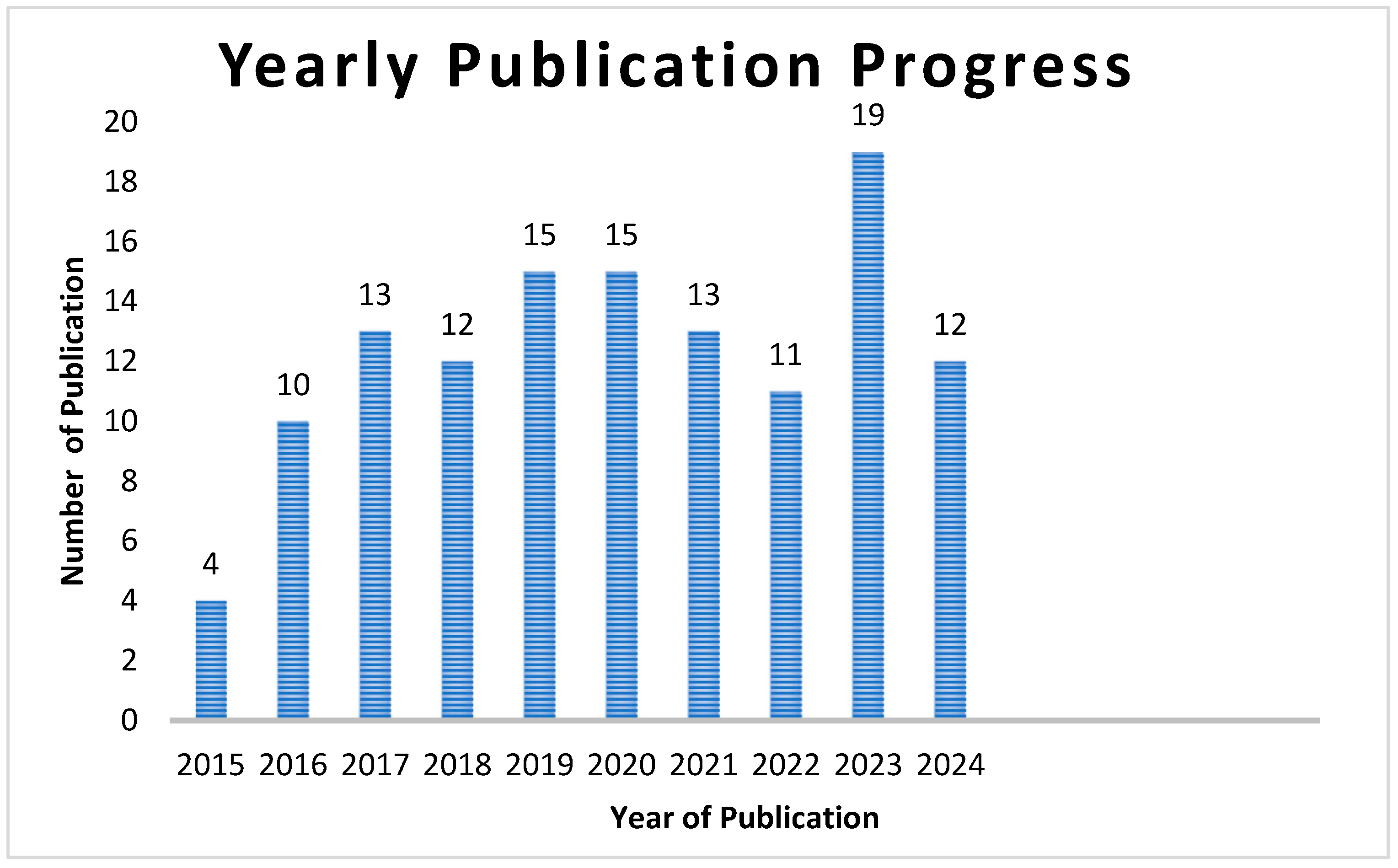
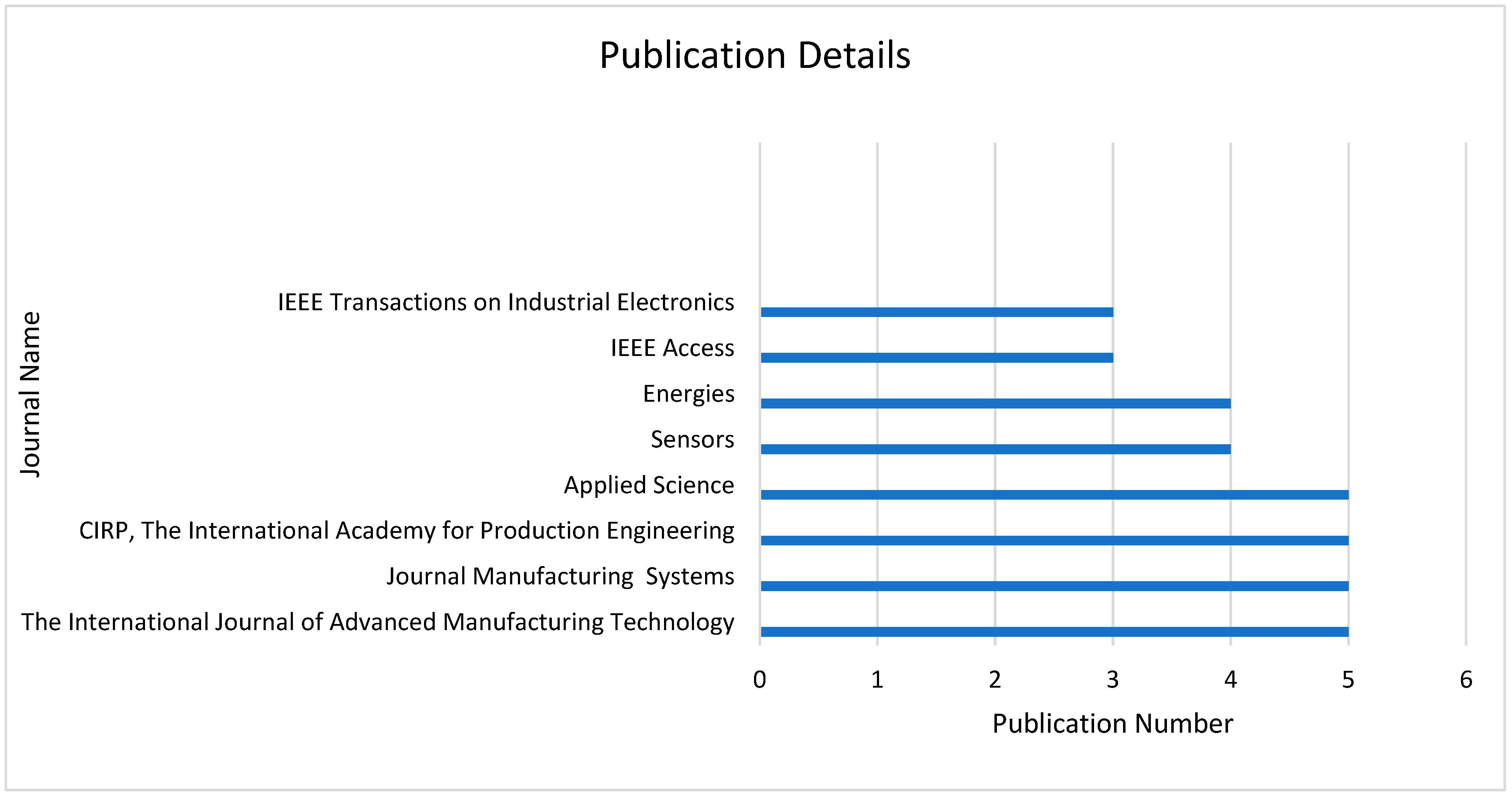
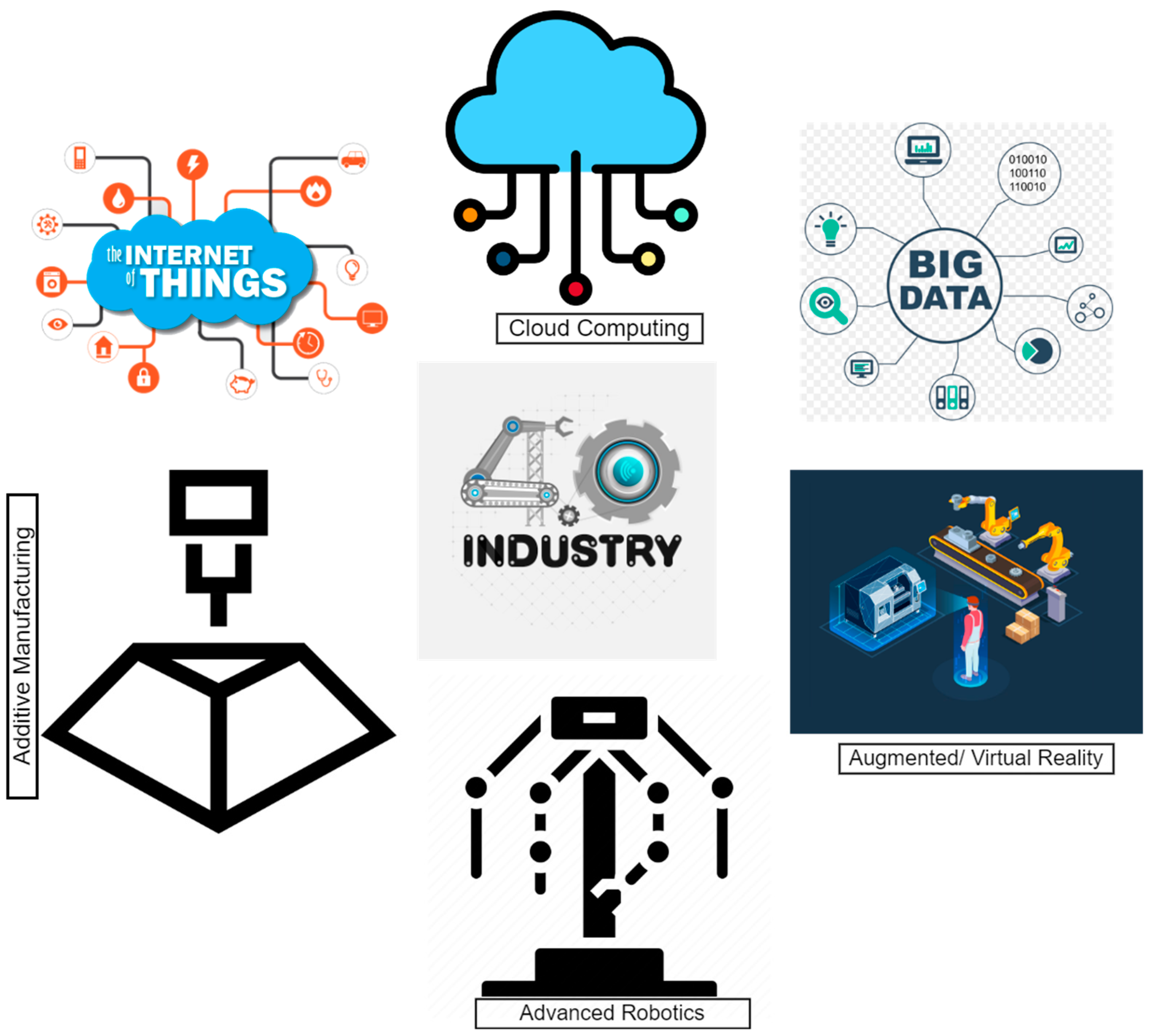
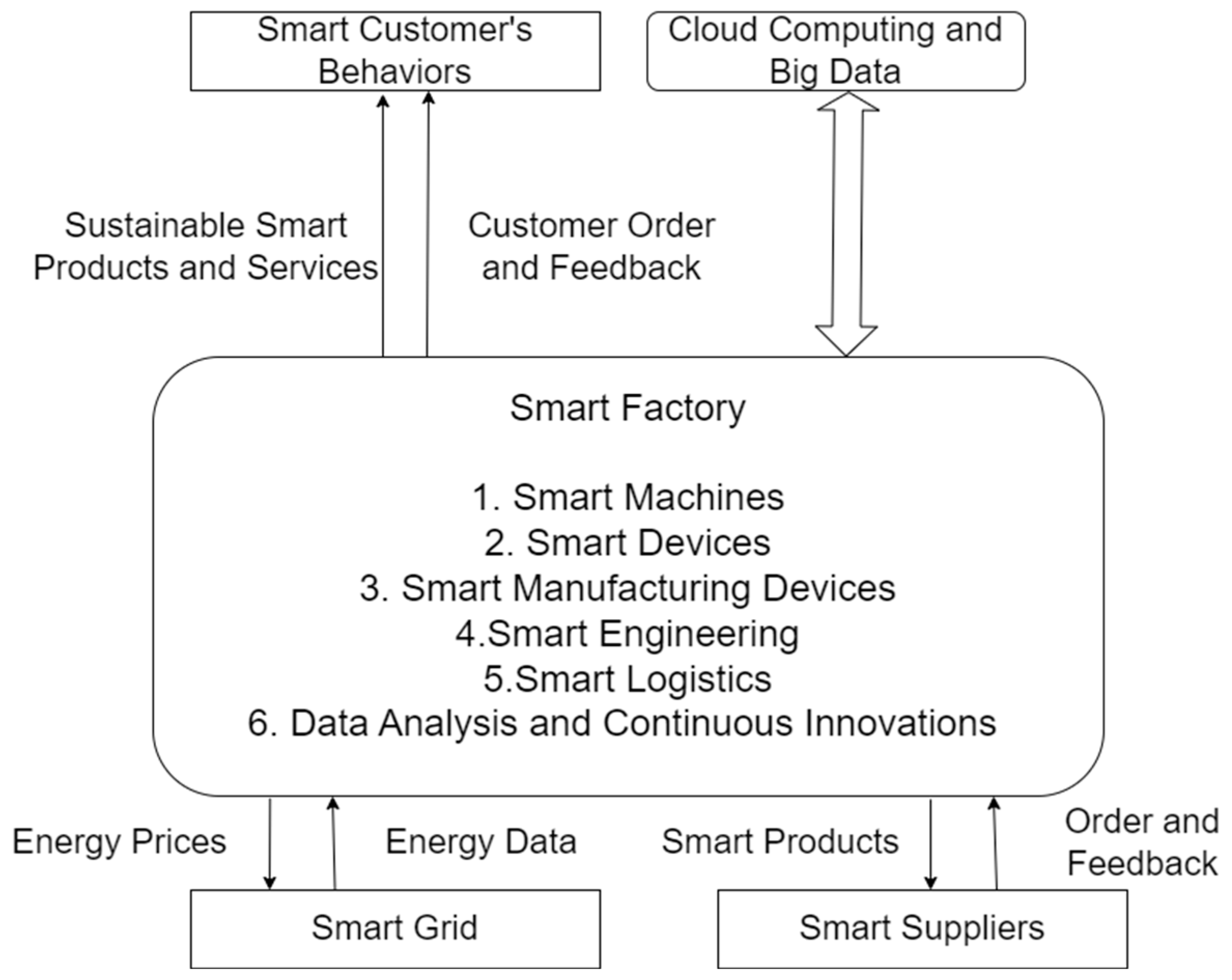
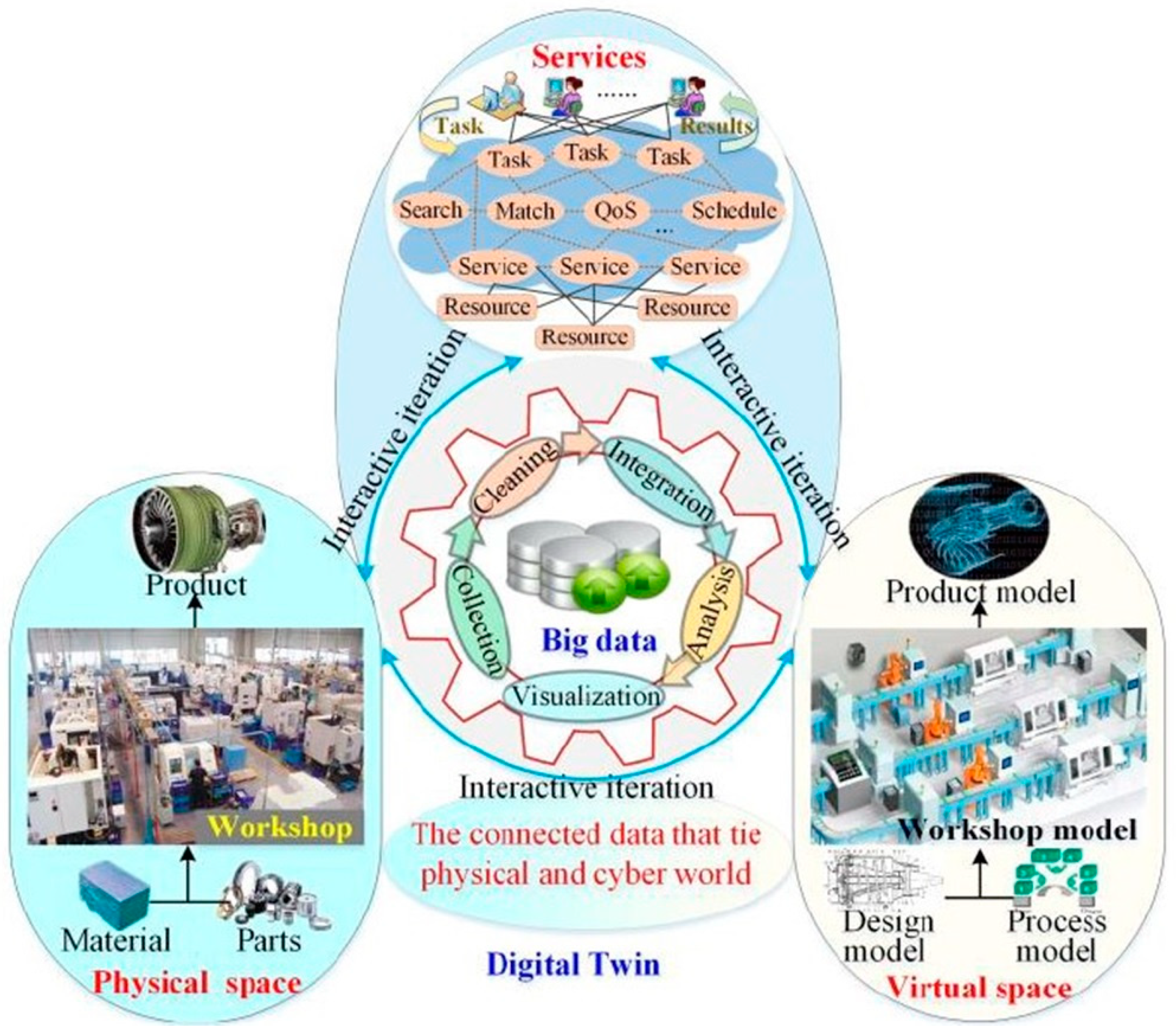
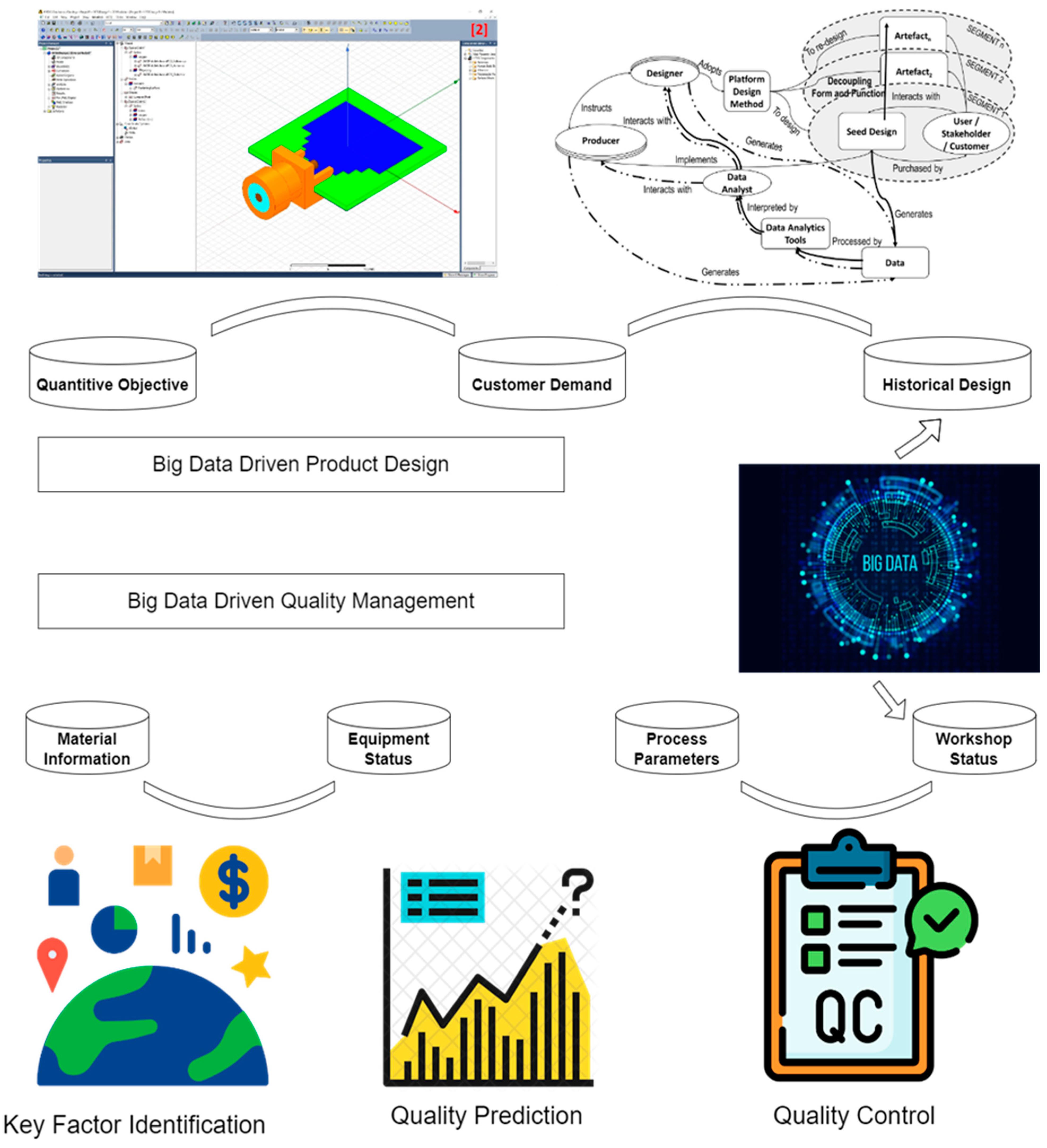
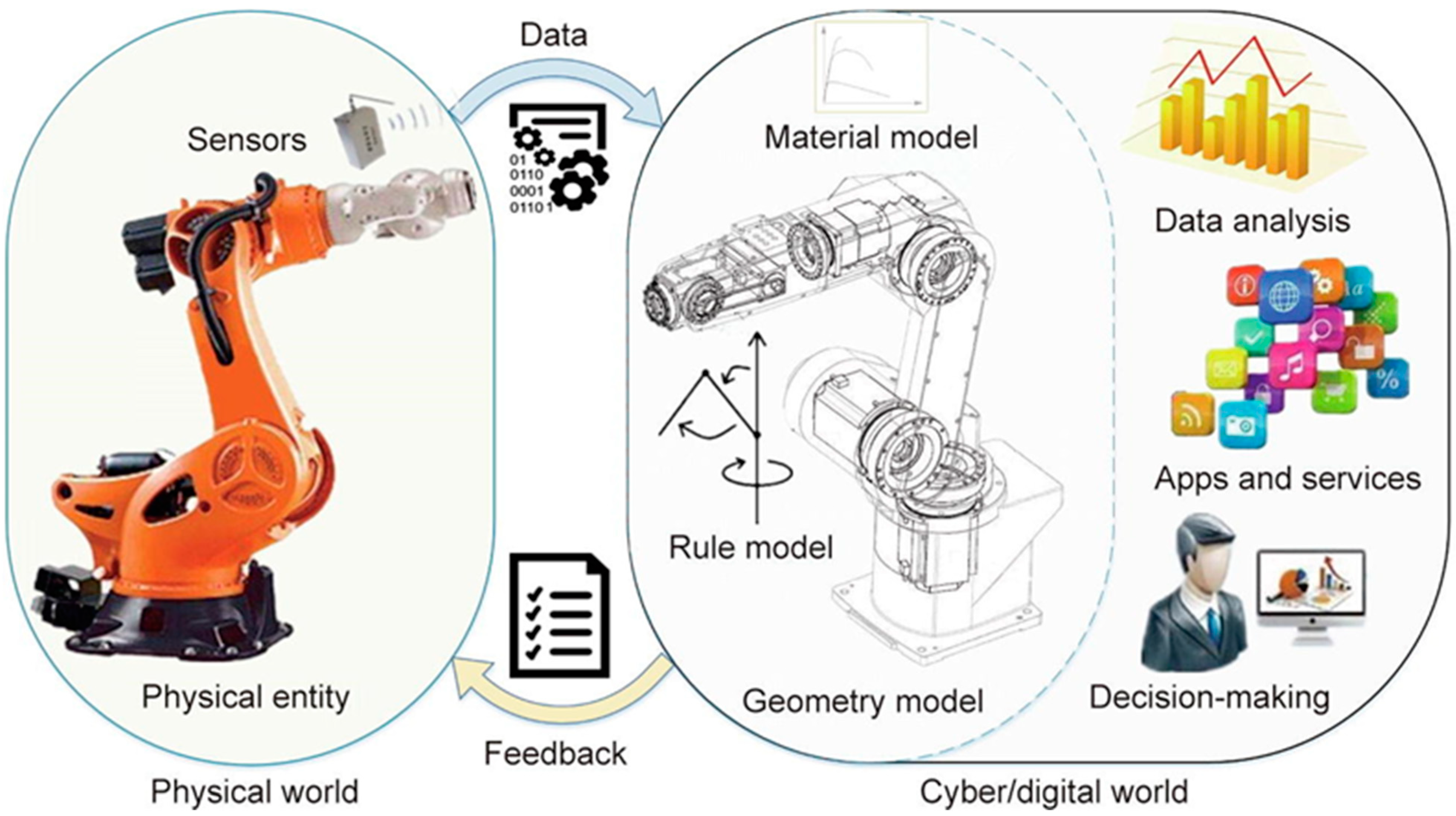
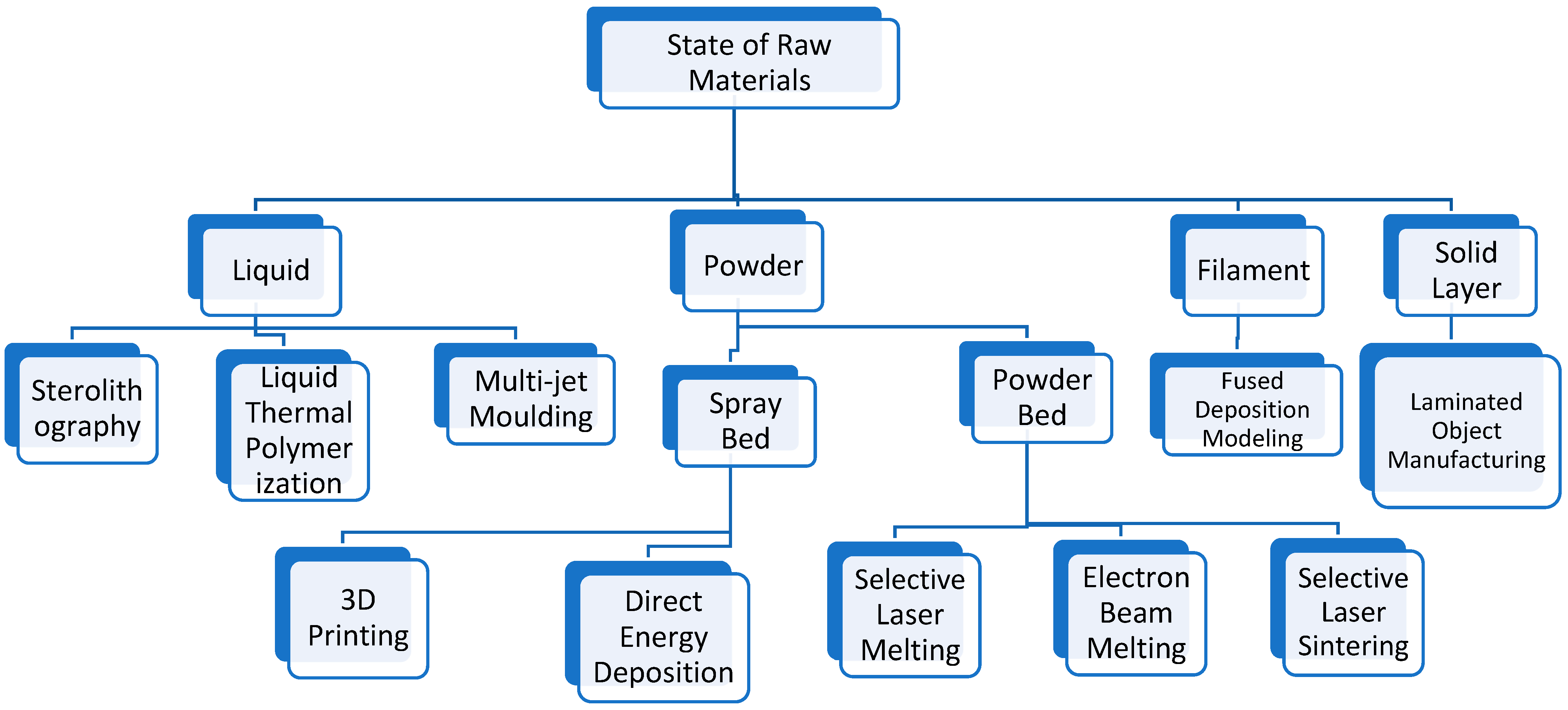
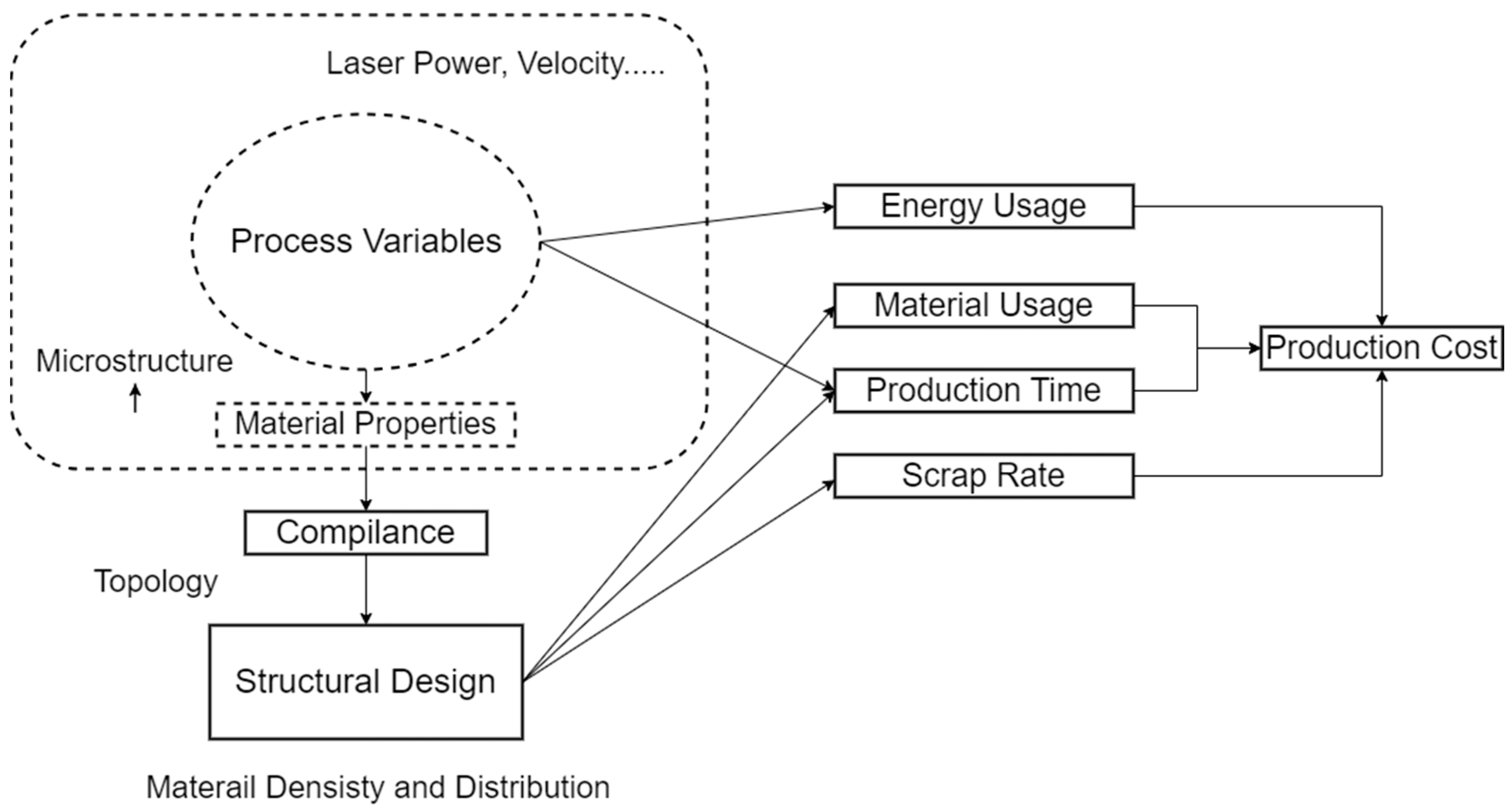
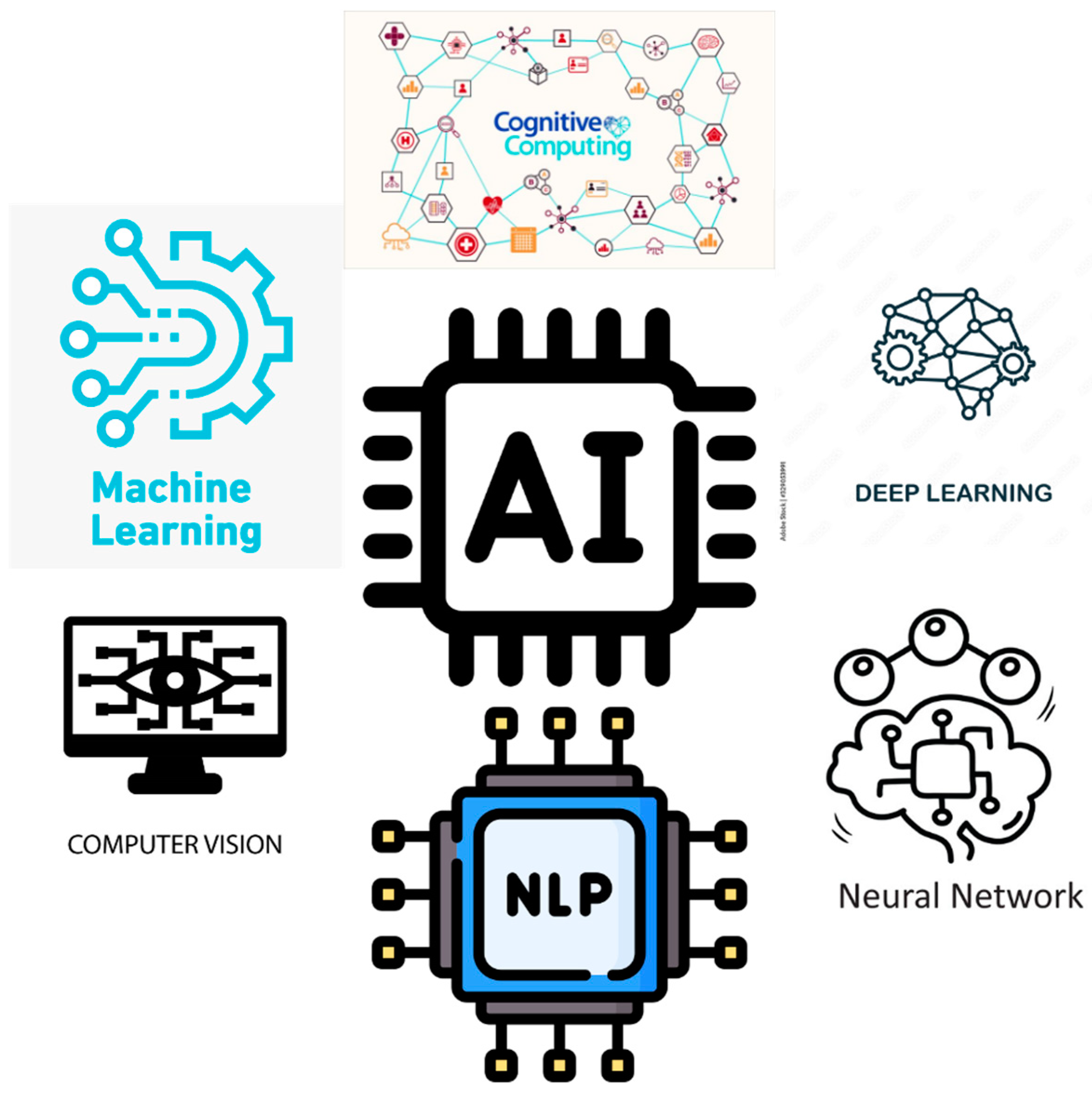
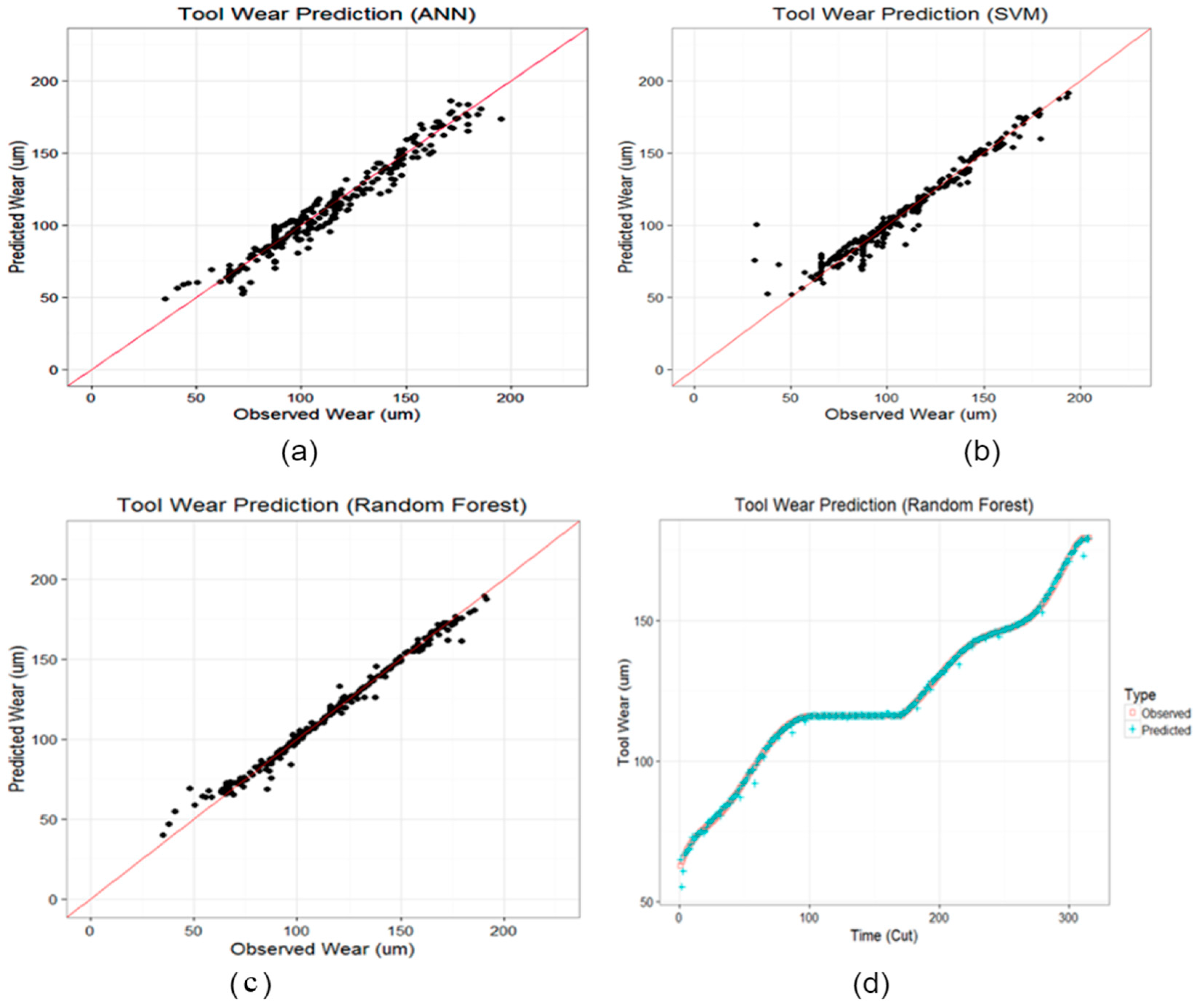

| Selection Criteria | Database and Strategies |
|---|---|
| Search Boundary | Google Scholar, Emerald, MDPI, Sage, Research Gate, Wiley, Scopus, Taylor & Francis |
| Core Keyword | Industry 4.0, Artificial Intelligence (AI), Material Processing, Manufacturing Efficiency |
| Combined Search Phrases | 1.”Industry 4.0” AND “Artificial Intelligence” AND “Material Processing” 2.”Internet of Things” AND “Material Processing” AND “Manufacturing Efficiency” 3. “Big Data Analytics” AND “Material Processing Optimization” 4. “Additive Manufacturing” OR “Robotics” AND “Industry 4.0” 6. “Machine Learning” AND “Process Optimization” OR “Material Processing” 7. “Deep Learning” AND “Defect Detection” AND “Material Processing” 8. “Reinforcement Learning” AND “Adaptive Manufacturing” 9. “AI-driven Predictive Maintenance” AND “Material Processing” |
| Inclusion | Exclusion | |
|---|---|---|
| Literature type | Indexed journals, book chapters, conference proceeding | Non-indexed journals, magazine articles |
| Timeline | Between the years 2000 and 2024 | Before the year 2000 |
| Language | English | Non-English |
| Full text | Accessible for detailed analysis | Only abstract/summary |
| Author | Contribution | Total Citations |
|---|---|---|
| Tao et al., 2018 | Addressing the current challenges of product life cycle data management and introducing a digital twin-driven approach to improve manufacturing efficiency. | 2825 |
| Monostori et al., 2016 | Providing the evolution and future direction of manufacturing systems by discussing the integration of CPS and CPPS, identifying historical contributions and current challenges. | 1981 |
| Widodo et al., 2007 | Providing an in-depth survey of Support Vector Machine (SVM) applications in machine condition monitoring and fault diagnosis, comparing it with other intelligent systems | 1842 |
| Wang et al., 2018 | Emphasizing the role of deep learning in handling big manufacturing data, characterized by high volume, velocity, and variety, enabled by the widespread deployment of sensors and IoT | 1620 |
| Qi et al., 2018 | Providing an in-depth analysis of the role of big data and digital twin (DT) in smart manufacturing | 1603 |
| Teti et al., 2010 | Summarizing a historical review of the contributions made by the International Academy for Production Engineering in the field of sensor monitoring of future machining operations | 1545 |
| Industry 4.0 Technologies | Description | Contribution | References |
|---|---|---|---|
| AM | AM is an advanced manufacturing process that is based on the addition of material to pre-determined path plans to produce three-dimensional (3D) geometries. | Waste reduction, cost saving, infinite part complexity, and material flexibility | [35,36,37] |
| Advanced Robotics | AI-driven robot to handle production tasks and task uncertainty autonomously. | Quick response time, precision, repeatability, error reduction | [38,39,40,41] |
| Augmented Virtual (AV) and Virtual Reality (VR) | AV and VR bridge virtual experiences with the real world. | Quality improvement, productivity | [42,43,44] |
| Cloud Computing | Cloud computing represents on-demand services that provide storage and even computational services over the internet. | Data management, on demand, eliminates error and ease of repetitive operations | [45,46,47,48] |
| IoT | IoT is a collective and collaborative network established between various machines, tools, clouds and devices. | Precise process control, remote monitoring higher quality | [49,50] |
| Big Data | Big data is used to gather insights into processes and assimilation that lead to decisions, investigations, etc. | Productivity improvement, condition monitoring, and energy-efficient optimization over manufacturing execution lifecycles | [51,52] |
| Data Analytics | Data analytics is a process of extraction of meaningful data to propose corrective actions and detect long-term trends. | Process improvement, fault detection | [53,54,55] |
| Advanced Monitoring and Maintenance (AMM) | AMM refers to real-time condition monitoring of equipment, which detects early failure conditions and predicts failures pre-emptively | Part quality, repeatability, preventative maintenance | [56,57] |
| Simulations/Analysis of Virtual Models | Simulation is a physics-based advanced computational tool used for virtual representation of real-world applications to predict process and material behavior that saves money, effort, and time. | Cost and time saving, process improvement | [58,59] |
| AI | Model Name | Description | Contribution | References |
|---|---|---|---|---|
| Supervised Learning | Regression | Using labeled data for use in many applications like prediction, classification | Process optimization for parameters, quality improvement | [70,71] |
| Classification | ||||
| Unsupervised Learning | Using unlabeled data which can discover insights and data patterns without any explicit guidance | Effective way of data mining, Identification of defects | [72,73] | |
| Semi-Supervised Learning | Self-Training | Handling mixed data, which have some labeled and some unlabeled | In situ quality control, automatic fault detection | [74,75] |
| Low-Density Separation Model | ||||
| Graph-Based Algorithm | ||||
| Reinforcement Learning | Dynamic Programming | Using AI agents, collects own data and improves data through trial-and-error | Prior process optimization, solving complex material handling situations | [76,77] |
| Monte Carlo Methods | ||||
| Heuristic Methods | ||||
| Deep Learning | Deep Feed Forward Networks | Subset of ML algorithm that can solve real-world problems without supervision | Material synthesis, material removal rate prediction, process failure prediction, material performance prediction | [78,79,80,81,82] |
| Convolution Neural Networks (CNN) | ||||
| Recurrent Neural Networks (RNN) | ||||
| Transformers | ||||
| Graph Neural Network |
| AI Technologies | Industry 4.0 Technologies | Main Contribution | References |
|---|---|---|---|
| Logistics Regressor CNN RNN | IoT | Anomaly data detection and predict future anomalous data | [118,119] |
| ML | IoT CPS Cloud Computing Big Data Analysis | Design improvements by a data-driven approach, predictive maintenance for early fault detection, product assessment | [120,121,122,123] |
| ML | IoT CPS | Real-time predictive analytics to visualize warnings, errors, and faults of manufacturing systems | [122] |
| ML | IoT CPS Cloud Computing | Condition-based real-time monitoring and predictive maintenance in a manufacturing line | [124] |
| ML | Big Data IoT | Anomaly detection and establishment of a method of feature extraction | [125] |
| Long Short-Term Memory Gated Recurrent Unit SVM | IoT | Spur gear faulty accuracy prediction in a manufacturing line | [126] |
| SVM Decision Trees Random Forests ANN MLP | IoT Cloud Computing Simulation CPS | Product line failure root cause analysis, assembly line fault detection, and real-time early detection | [125,127] |
| CNN | IoT Cloud Computing Simulation | Employed deep learning method for early fault detection in the manufacturing line | [127,128] |
| CNN | Cloud Computing IoT | Quality control | [129,130] |
| SVM Decision Trees RF KNN | Big Data IoT | Material classification and discovery in the raw material industry | [131,132] |
Disclaimer/Publisher’s Note: The statements, opinions and data contained in all publications are solely those of the individual author(s) and contributor(s) and not of MDPI and/or the editor(s). MDPI and/or the editor(s) disclaim responsibility for any injury to people or property resulting from any ideas, methods, instructions or products referred to in the content. |
© 2024 by the authors. Licensee MDPI, Basel, Switzerland. This article is an open access article distributed under the terms and conditions of the Creative Commons Attribution (CC BY) license (https://creativecommons.org/licenses/by/4.0/).
Share and Cite
Ahmmed, M.S.; Isanaka, S.P.; Liou, F. Promoting Synergies to Improve Manufacturing Efficiency in Industrial Material Processing: A Systematic Review of Industry 4.0 and AI. Machines 2024, 12, 681. https://doi.org/10.3390/machines12100681
Ahmmed MS, Isanaka SP, Liou F. Promoting Synergies to Improve Manufacturing Efficiency in Industrial Material Processing: A Systematic Review of Industry 4.0 and AI. Machines. 2024; 12(10):681. https://doi.org/10.3390/machines12100681
Chicago/Turabian StyleAhmmed, Md Sazol, Sriram Praneeth Isanaka, and Frank Liou. 2024. "Promoting Synergies to Improve Manufacturing Efficiency in Industrial Material Processing: A Systematic Review of Industry 4.0 and AI" Machines 12, no. 10: 681. https://doi.org/10.3390/machines12100681
APA StyleAhmmed, M. S., Isanaka, S. P., & Liou, F. (2024). Promoting Synergies to Improve Manufacturing Efficiency in Industrial Material Processing: A Systematic Review of Industry 4.0 and AI. Machines, 12(10), 681. https://doi.org/10.3390/machines12100681







